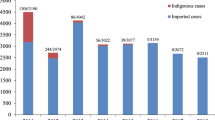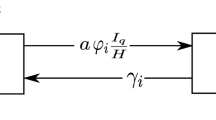Abstract
A mathematical model for malaria in humans was developed to explore the effect of treatment on the transmission and control of malaria. The model incorporates effective antimalarial and substandard drugs as treatment for infectious humans. The reproduction number \(R_{0}\) is evaluated, and shown to increase due to the presence of partially recovered humans. The disease free equilibrium is locally asymptotically stable when \(R_{0}<1\) and unstable when \(R_{0}>1\). The model exhibits backward, imperfect or transcritical bifurcation depending on the value of the disease induced death rate and \(R_{0}\). The numerical simulations, local and global sensitivity analysis suggest that the combination of effective control measures and the prompt use of effective antimalarial drugs that clear parasites quickly and give a long post-treatment prophylaxis may not only prevent transmission of infection to mosquitoes, but significantly reduce the number of infectious humans and the overall sources of infection.









Similar content being viewed by others
References
Agusto, F.B., Del Valle, S.Y., Blayneh, K.W., Ngonghala, C.N., Goncalves, M.J., Li, N., Zhao, R., Gong, H.: The impact of bed-net use on malaria prevalence. J. Theor. Biol. 320, 58–65 (2013)
Agusto, F.B., Marcus, N., Okosun, K.O.: Application of optimal control to the epidemiology of malaria. Electron. J. Differ. Equ. 81, 1–22 (2012)
Anderson, B., Jackson, J., Sitharam, M.: Descartes’ rule of signs revisited. Am. Math. Mon. 105, 447–451 (1998)
Awuah, R.B., Asante, P.Y., Sakyi, L., Biney, A.A., Kushitor, M.K., Agyei, F., Aikins, A.D.G.: Factors associated with treatment-seeking for malaria in urban poor communities in Accra, Ghana. Malar. J. 17, 168 (2018)
Badu, K., Brenya, R.C., Timmann, C., Garms, R., Kruppa, T.F.: Malaria transmission intensity and dynamics of clinical malaria incidence in a mountainous forest region of Ghana. Malar. World J. 4, 14 (2013)
Bate, R.: Making a killing: the deadly implications of the counterfeit drug trade. American Enterprise Institute (2008)
Cai, L.M., Lashari, A.A., Jung, I.H., Okosun, K.O., Seo, Y.I.: Mathematical analysis of a malaria model with partial immunity to reinfection. In: Abstract and Applied Analysis, Vol. 2013. Hindawi (2013)
Cariboni, J., Gatelli, D., Liska, R., Saltelli, A.: The role of sensitivity analysis in ecological modelling. Ecol. Model. 203, 167–182 (2007)
Chitnis, N.R.: Using mathematical models in controlling the spread of malaria. University of Arizona, Ph.D. diss. (2005)
Chiyaka, C., Garira, W., Dube, S.: Transmission model of endemic human malaria in a partially immune population. Math. Comput. Model. 46, 806–822 (2007)
Ghana Statistical Service: Ghana multiple indicator cluster survey with an enhanced malaria module and biomarker 2011 final report. Tech. Rep, Ghana Statistical Service (2011)
Huo, H.F., Qiu, G.M.: Stability of a mathematical model of malaria transmission with relapse. In: Abstract and Applied Analysis, Vol. 2014. Hindawi (2014)
Kasasa, S., Asoala, V., Gosoniu, L., Anto, F., Adjuik, M., Tindana, C., Smith, T., Owusu-Agyei, S., Vounatsou, P.: Spatio-temporal malaria transmission patterns in Navrongo demographic surveillance site, northern Ghana. Malar. J. 12, 63 (2013)
Klassen, W.: Introduction: development of the sterile insect technique for African malaria vectors (2009)
Koram, K.A., Abuaku, B., Duah, N., Quashie, N.: Comparative efficacy of antimalarial drugs including ACTs in the treatment of uncomplicated malaria among children under 5 years in Ghana. Acta Trop. 95, 194–203 (2005)
Lewis, E.R.: Network Models in Population Biology, vol. 7. Springer, Berlin (2012)
Marshall, J.M., Taylor, C.E.: Malaria control with transgenic mosquitoes. PLoS Med. 6, e1000020 (2009)
Nayyar, G.M., Breman, J.G., Newton, P.N., Herrington, J.: Poor-quality antimalarial drugs in southeast Asia and sub-Saharan Africa. Lancet Infect. Dis. 12, 488–496 (2012)
Newton, P.N., Green, M.D., Mildenhall, D.C., Plançon, A., Nettey, H., Nyadong, L., Hostetler, D.M., Swamidoss, I., Harris, G.A., Powell, K., et al.: Poor quality vital anti-malarials in Africa-an urgent neglected public health priority. Malar. J. 10, 352 (2011)
Ngwa, G.A., Shu, W.S.: A mathematical model for endemic malaria with variable human and mosquito populations. Math. Comput. Model. 32, 747–763 (2000)
Niger, A.M., Gumel, A.B.: Mathematical analysis of the role of repeated exposure on malaria transmission dynamics. Differ. Equ. Dyn. Syst. 16, 251–287 (2008)
Oduro, A.R., Anyorigiya, T., Hodgson, A., Ansah, P., Anto, F., Ansah, N.A., Atuguba, F., Mumuni, G., Amankwa, J.: A randomized comparative study of chloroquine, amodiaquine and sulphadoxine-pyrimethamine for the treatment of uncomplicated malaria in Ghana. Trop. Med. Int. Health 10, 279–284 (2005)
Okosun, K.O., Ouifki, R., Marcus, N.: Optimal control strategies and cost-effectiveness analysis of a malaria model. BioSystems 111, 83–101 (2013)
Parham, P.E., Michael, E.: Modeling the effects of weather and climate change on malaria transmission. Environ. Health Perspect. 118, 620–626 (2009)
Renschler, J.P., Walters, K.M., Newton, P.N., Laxminarayan, R.: Estimated under-five deaths associated with poor-quality antimalarials in sub-Saharan Africa. Am. J. Trop. Med. Hyg. 92, 119–126 (2015)
Sayang, C., Gausseres, M., Vernazza-Licht, N., Malvy, D., Bley, D., Millet, P.: Treatment of malaria from monotherapy to artemisinin-based combination therapy by health professionals in rural health facilities in southern Cameroon. Malar. J. 8, 174 (2009)
Stone, C.M., Lindsay, S.W., Chitnis, N.: How effective is integrated vector management against malaria and lymphatic filariasis where the diseases are transmitted by the same vector? PLoS Negl. Trop. Dis. 8, e3393 (2014)
Strogatz, S.H.: Nonlinear Dynamics and Chaos: with Applications to Physics, Biology, Chemistry, and Engineering. Perseus Books Publishing, New York (1994)
Stuckey, E.M., Stevenson, J., Galactionova, K., Baidjoe, A.Y., Bousema, T., Odongo, W., Kariuki, S., Drakeley, C., Smith, T.A., Cox, J., et al.: Modeling the cost effectiveness of malaria control interventions in the highlands of western Kenya. PloS One 9, e107700 (2014)
Tay, S., Danuor, S., Mensah, D., Acheampong, G., Abruquah, H., Morse, A., Caminade, C., Badu, K., Tompkins, A., Hassan, H.: Climate variability and malaria incidence in peri-urban, urban and rural communities around Kumasi, Ghana: a case study at three health facilities; Emena, Atonsu and Akropong. Int. J. Parasitol Res. 4, 83 (2012)
Tchouassi, D., Quakyi, I., Addison, E., Bosompem, K., Wilson, M., Appawu, M., Brown, C., Boakye, D.: Characterization of malaria transmission by vector populations for improved interventions during the dry season in the Kpone-on-sea area of coastal Ghana. Parasit. Vectors 5, 212 (2012)
Tumwiine, J., Mugisha, J., Luboobi, L.S.: A mathematical model for the dynamics of malaria in a human host and mosquito vector with temporary immunity. Applied Mathematics and Computation 189, 1953–1965 (2007)
Van den Driessche, P., Watmough, J.: Reproduction numbers and sub-threshold endemic equilibria for compartmental models of disease transmission. Mathematical Biosciences 180, 29–48 (2002)
World Health Organization: Guidelines for the treatment of malaria. World Health Organization, Tech. Rep. (2015)
World Health Organization: World malaria report 2016. World Health Organization, Tech. Rep. (2016)
World Health Organization: Ghana: WHO statistical profile. World Health Organization, Tech. Rep. (2017)
World Health Organization: World malaria report 2018. World Health Organization, Tech. Rep. (2018)
Author information
Authors and Affiliations
Corresponding author
Additional information
Publisher's Note
Springer Nature remains neutral with regard to jurisdictional claims in published maps and institutional affiliations.
Rights and permissions
About this article
Cite this article
Danquah, B.A., Chirove, F. & Banasiak, J. Effective and ineffective treatment in a malaria model for humans in an endemic region. Afr. Mat. 30, 1181–1204 (2019). https://doi.org/10.1007/s13370-019-00713-z
Received:
Accepted:
Published:
Issue Date:
DOI: https://doi.org/10.1007/s13370-019-00713-z




